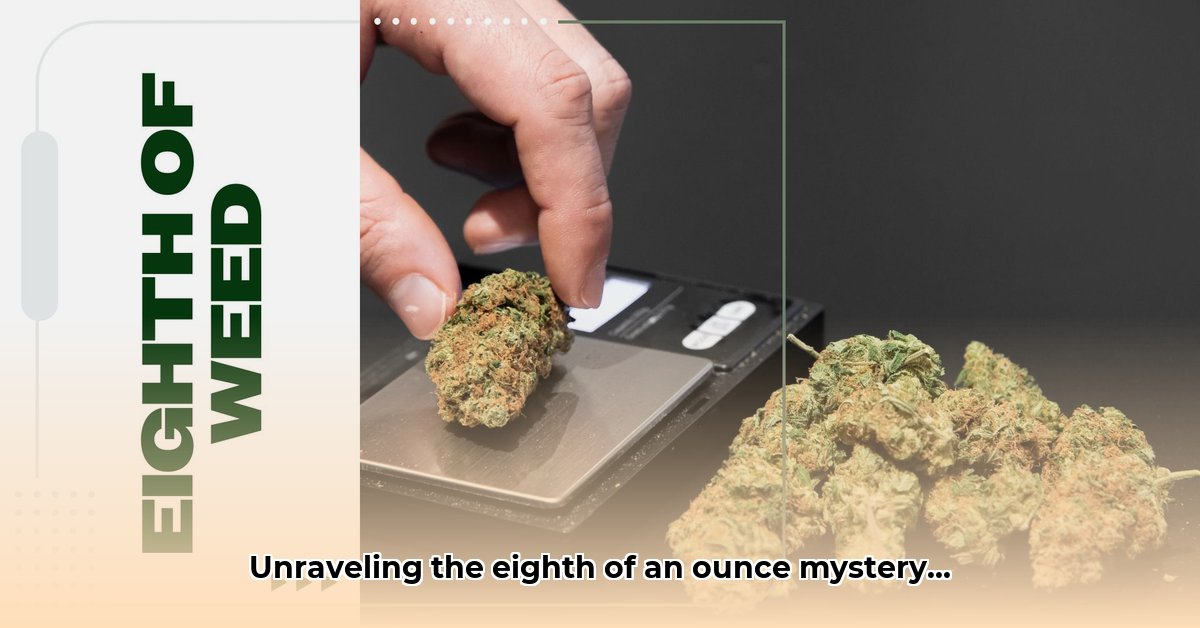“`markdown
How Many Grams in an Eighth of an Ounce: A Comprehensive Guide
Ever wondered how much cannabis is actually in an “eighth”? It can be tricky figuring out cannabis weights, right? Whether you’re buying, selling, or just tracking your stash, knowing the difference between an eighth, a quarter, or a half-ounce is essential. This complete guide provides a detailed breakdown of cannabis weights and conversions, ensuring clarity and accuracy for everyone. We’ll simplify the process with step-by-step explanations, practical tips, and a comprehensive conversion chart, making it easy to understand, regardless of your experience level. Let’s start unraveling the world of cannabis measurements!
Demystifying Cannabis Weight Measurements
Confused by cannabis measurements? Terms like “eighth” and “ounce” can be perplexing. Let’s clarify these measurements, making it easy to understand exactly how much cannabis you are getting. This guide simplifies weights and measures, enabling you to confidently navigate ounces, grams, and everything in between, including common cannabis measurements.
Ounces, Grams, and Fractions: Breaking It Down
In the cannabis market, you’ll frequently encounter ounces (oz) and their fractional parts. Imagine a pizza: a whole pizza represents an ounce, which can be divided into smaller slices – eighths, quarters, and halves. However, legal standards and precise transactions often require measurements in grams (g). This is where a bit of math comes in, but don’t worry, we’ll make it simple.
One ounce is approximately 28.35 grams. The exact number is 28.3495 grams, but 28.35 is generally used for practical purposes. This simple conversion is essential for understanding all other measurements.
Calculating Grams in an Eighth of Cannabis: Step-by-Step
An “eighth” is one-eighth of an ounce. To determine how many grams are in an eighth, divide the grams in an ounce (28.35g) by 8.
The result? Approximately 3.54 grams. Precise calculations are crucial to avoid confusion or issues, especially when paying for cannabis. Weighing your cannabis after purchase can ensure accurate amounts.
Comprehensive Cannabis Conversion Chart
Keep this handy table nearby for quick reference:
| Unit | Ounces (oz) | Grams (g) (Approximate) |
|---|---|---|
| Eighth | 0.125 | 3.54 |
| Quarter | 0.25 | 7.09 |
| Half | 0.5 | 14.17 |
| One Ounce | 1 | 28.35 |
This table provides a clear overview of standard cannabis weights and measures. Knowing these conversions is advantageous for both consumers and retailers.
The Importance of Precise Cannabis Weighing
Accurate measurement is vital for buyers and sellers. For buyers, it ensures you’re getting the correct amount of product. For sellers, accurate weighing is essential for legal compliance and maintaining fair business practices.
The most accurate measurement method involves using a digital scale. Digital scales offer far more precise measurements than estimations. Always use a calibrated scale for accuracy.
Understanding Factors Affecting Marijuana Weight
The weight of cannabis can be affected by several factors, most notably moisture content. Dried cannabis weighs less than fresh cannabis due to water loss. Proper cannabis storage techniques can help maintain weight accuracy.
Frequently Asked Questions (FAQ)
Q: Are there official regulations for weighing cannabis?
A: Regulations vary by location, with some jurisdictions having strict rules regarding labeling and acceptable weight variations. Consult local laws for specific requirements. State regulations often mandate specific weighing procedures.
Q: Why are measurements like eighths, quarters, and halves still used?
A: These fractional measurements are a holdover from the days when cannabis was illegal. Despite legalization, these terms have persisted due to tradition.
Q: What should I do if my cannabis weighs less than expected?
A: Minor discrepancies can occur due to factors like packaging and moisture levels. However, significant differences should be addressed with the seller. Purchase cannabis from reputable sources that employ accurate weighing procedures.
Mastering Accurate Cannabis Weighing for Compliance
Mastering accurate cannabis weighing for legal compliance is critical. Whether you’re a consumer, grower, or working in the cannabis industry, precise measurement is essential and often legally mandated. Inconsistent measurements can lead to pricing discrepancies, dosage errors, and violations of legal purchase limits. This section provides detailed steps and actionable insights for accurate weight measurement.
Key Takeaways:
- Accurate weighing ensures fair pricing, consumer satisfaction, and compliance with regulations.
- Standard units (grams, ounces, eighths, quarters, halves) are commonly used.
- A digital scale is indispensable, especially for medical users requiring precise dosages.
- Visual estimation is unreliable.
- Local purchase limits vary significantly.
Cannabis Weights and Measures: A Closer Look
Understanding accurate cannabis weighing for legal compliance and consistent dosing is essential for consumers and professionals. Inconsistent measurements lead to various issues, including pricing problems, inaccurate dosages, and non-compliance with purchase limits.
You’ll commonly encounter grams (g) and ounces (oz), along with fractions like eighths, quarters, and halves, which represent fractions of an ounce. Accurate conversions between these units are vital.
Accurate Cannabis Conversions: A Detailed Table
Refer to this table for accurate conversions:
| Unit | Ounces (oz) | Grams (g) (approx.) |
|---|---|---|
| Eighth | 0.125 | 3.54 |
| Quarter | 0.25 | 7.09 |
| Half | 0.5 | 14.17 |
| Ounce | 1 | 28.35 |
These conversions are approximate, and actual weights can vary depending on cannabis strain and density. Always use a calibrated digital scale for accurate measurements.
Using Digital Scales for Accurate Weighing
Digital scales are essential tools for accurate cannabis weighing. Visual estimation is unreliable due to size and density variations in cannabis buds.
A digital scale provides precise measurements in grams, which is crucial for medical cannabis patients needing accurate dosages and for ensuring compliance with purchase limits.
Step-by-Step Guide to Weighing Cannabis
- Calibrate the scale: Ensure your scale is calibrated before use.
- Zero the scale: Zero the scale to eliminate any pre-existing weight.
- Gently place the cannabis: Carefully place the cannabis on the scale.
- Read and record: Note the weight to track usage and ensure legal compliance.
Compliance Points
Compliance is key when it comes to cannabis purchase limits. State and local laws vary significantly. Staying informed is essential to avoid legal issues.
Frequently Asked Questions (FAQ)
- Q: Are there standard dosage guidelines for cannabis? A: No universal guidelines exist due to varied individual responses. Start with a minimal amount, assess the effects, and adjust.
- Q: What should I do if my purchase weight is off? A: Minor variations can occur, but major discrepancies should be addressed with the retailer.
Optimizing Cannabis Weighing for Safety and Compliance
Accurate cannabis weighing is a critical practice that reinforces legal compliance and consumer protection. Measurements that are inconsistent can impact buyers and seller. Accurate communication helps and further ensures practices that are fair for everyone.
Key Takeaways:
- In the Cannabis industry, it is key to understand the weight measurements for consumers, and retailers alike.
- Accurate weighing helps to create fair pricing, avoiding legal issues.
- Scales that are digital provides accuracy and visual estimations can be innacurate.
- Become familiar with the units (grams, eighths, ounces).
- Understand any legal limits based on the location.
The Basics of Cannabis Measurements
Cannabis industry uses a variety of “`
- Why an App Appeared on My Phone Unexpectedly - November 22, 2025
- How to Stop Unwanted Apps from Automatically Downloading on Android - November 21, 2025
- Why Are Android Games Installing Themselves on Your Phone? - November 20, 2025










